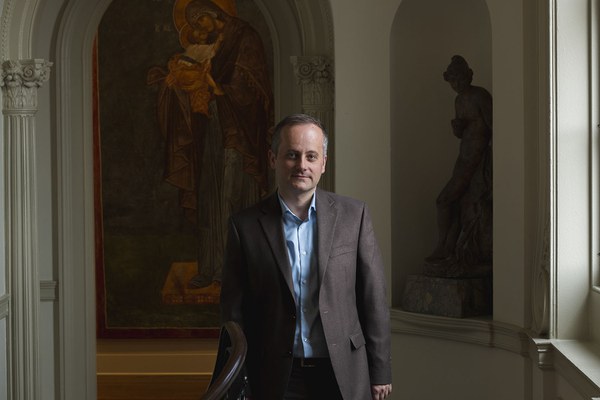Christos Simelidis, assistant professor of late antique and Byzantine literature at the Aristotle University of Thessaloniki, was a 2018–2019 fellow in Byzantine Studies. His research report, “John Geometres’s The Life of the Virgin Mary: Edition and Translation,” presented an unpublished 10th-century text that illuminates the history of Marian devotion in Byzantium.
Q&A with Christos Simelidis
Who was John Geometres, and what makes your edition and translation of his work important?
John Geometres was one of the most esteemed poets and authors in Byzantium. He was the poet laureate of his time (the second half of the 10th century), but we don’t know much about his life, for which our only source is his own poems. He was a military officer of high rank and belonged to a lay confraternity attached to the church of the Theotokos in the district of Constantinople known as “ta Kyrou.”
Although Geometres’s profile as a poet and critic has received considerable attention, Geometres the theologian remains mostly unstudied. His most important work, The Life of the Virgin Mary, remains unpublished. This is the most comprehensive treatment of the Virgin’s life produced by any author up to his time. My project, which I’m collaborating on with Fr. Maximos Constas, will produce an edition of the Greek text and an English translation, to be published in the Dumbarton Oaks Medieval Library series. This text, which is considered a critical missing piece in a larger puzzle connecting early Marian writings with later works, will undoubtedly be valuable to students and scholars.
The preparation of text editions and translations is of fundamental importance for medieval Greek, where significant texts, even by major authors, remain unpublished or are only available in old, unreliable editions.
What are the challenges you are facing in your work?
Editing a text involves collating the Byzantine manuscripts it’s found in. This is necessary because the authors’ autographs (their original manuscripts) of almost all ancient and Byzantine texts do not survive. Today we only have faulty copies, which derive from the original through an unknown number of intermediate copies. We need to reconstitute the text Geometres originally wrote, so we look for such errors in the three manuscripts transmitting his Life of the Virgin. Doing this also helps us establish the relationships between the manuscripts: for example, if copies share the same error, it first occurred either in one of them or in a common ancestor.
John Geometres was a highly accomplished and original Byzantine author. His inventive and often inspired poetry, and the verbal artistry of his rhetorical prose works, have been commended by scholars. His Greek is often very elaborate and not easy to understand, let alone translate into English.
Another challenge is the longstanding question about the relationship of Geometres’s text to a Georgian Life of the Virgin attributed to the 7th-century Byzantine theologian Maximus the Confessor. During the first months of my fellowship I wrote a substantial article that offers my response to this debate. It is based on a rereading of these texts, without the questionable assumptions imposed on them by modern scholars.
The evidence offered by some Athonite manuscripts was extremely important. Working with original manuscripts is one of the pleasures of editing a text, although in recent years, visiting a library to consult manuscripts is becoming unnecessary: high quality scans can be sent by email or are uploaded online by the libraries. As classics scholar Michael Winterbottom recently observed, this is “convenient but unromantic.”
You also reported some discoveries at Mount Athos related to Dumbarton Oaks.
My research on Athonite manuscripts and related archives at Mount Athos in Greece revealed an autograph note, dated 6 June 1953, written by Dumbarton Oaks cofounder Robert Woods Bliss in the guestbook of the Holy Monastery of Dionysiou: “It is in a spirit of reverence that I came to this monastery to view the great manuscripts of its library which contain the most outstanding and well preserved manuscripts ever existing. I am grateful for the privilege of having been allowed to see them. Robert Woods Bliss, Co-founder of Dumbarton Oaks Research Library and Collection in Washington D.C.” Prior to this discovery, Bliss's visit to Athos had been unknown and undocumented.
During this visit, Robert Bliss was accompanied by John Thacher, the first director of Dumbarton Oaks. Interestingly, the guestbook also reveals that Thacher and Marvin Ross, curator of medieval art at the Walters Art Museum in Baltimore, had visited the same Athonite monastery a year before: “For the pleasure of having seen the most superb manuscripts on Mt. Athos and all the other treasures. June 10, 1952. Marvin Ross, Walters Art Gallery, Baltimore MD. John Thacher, Dumbarton Oaks, Washington DC.”
Julia Ostmann is Postgraduate Writing and Reporting Fellow at Dumbarton Oaks. Photo by Elizabeth Muñoz Huber, Postgraduate Digital Media Fellow.

